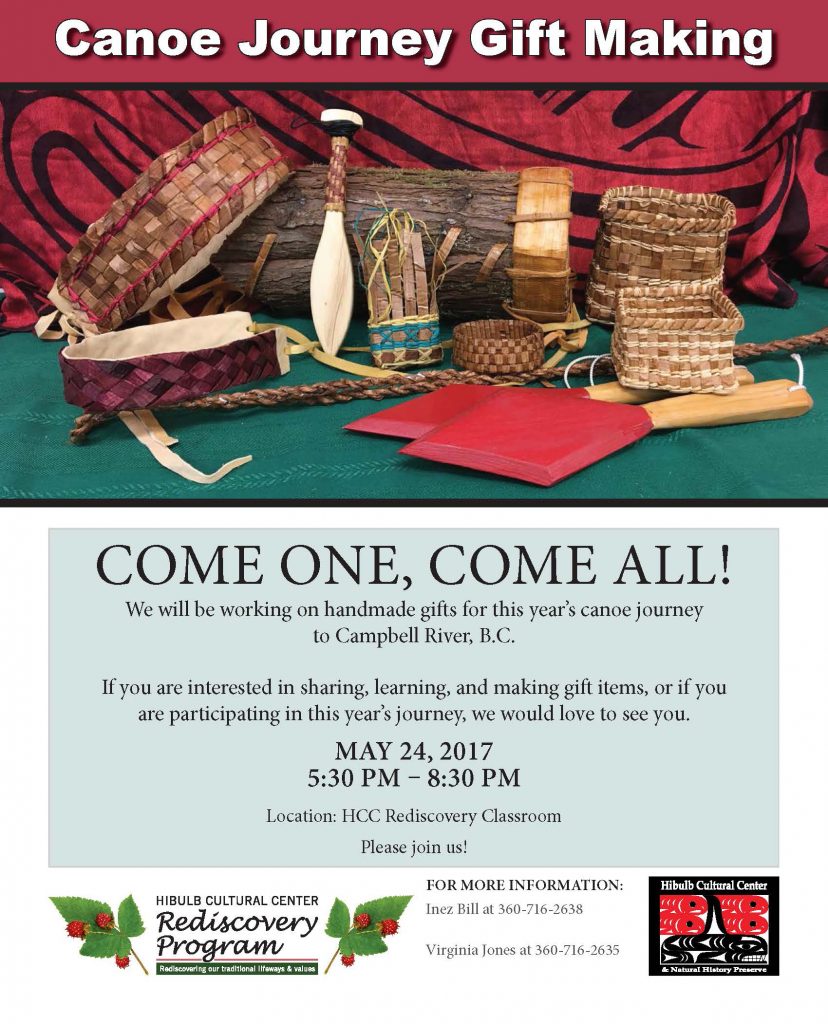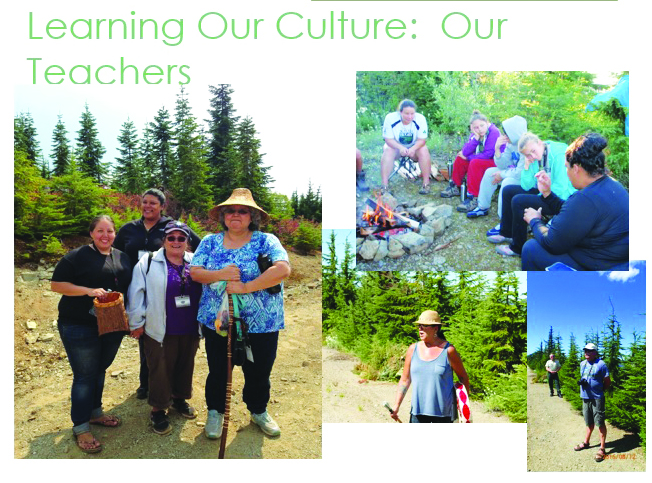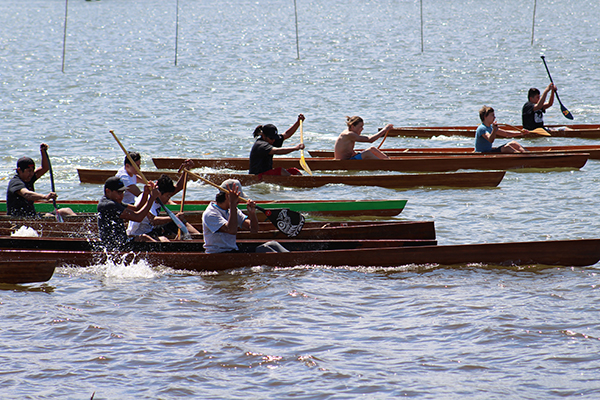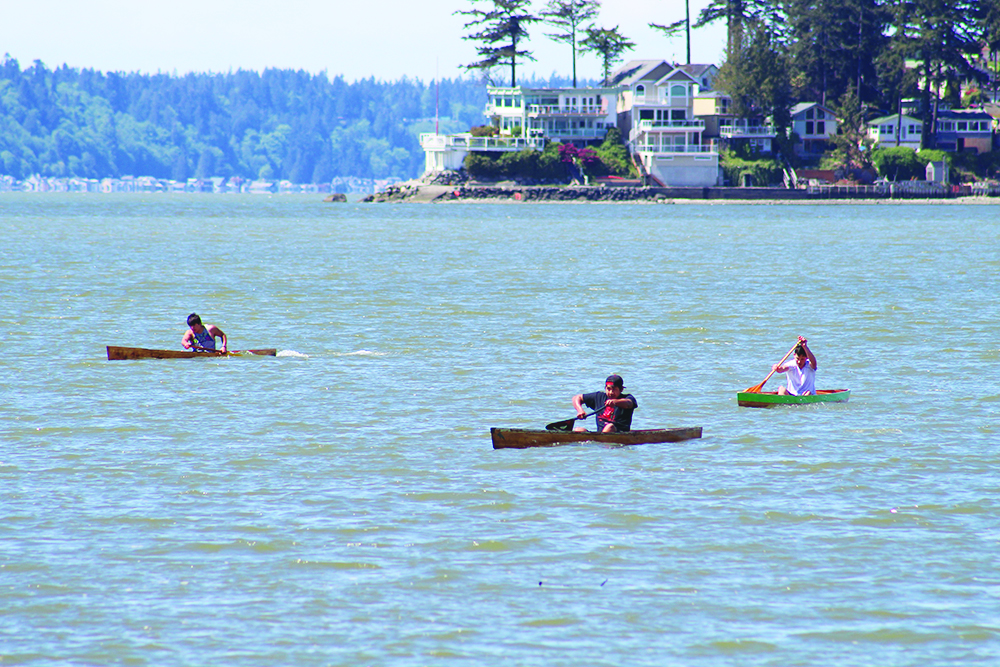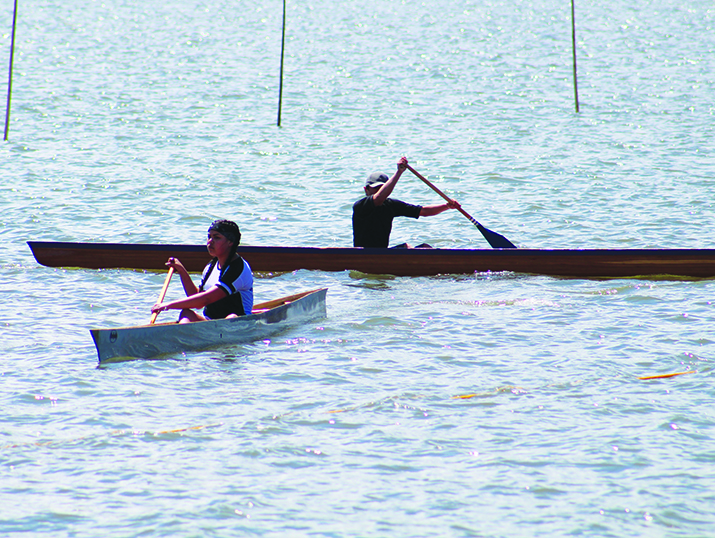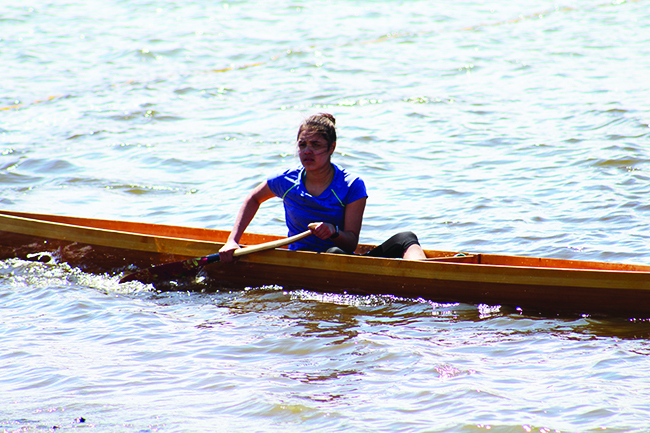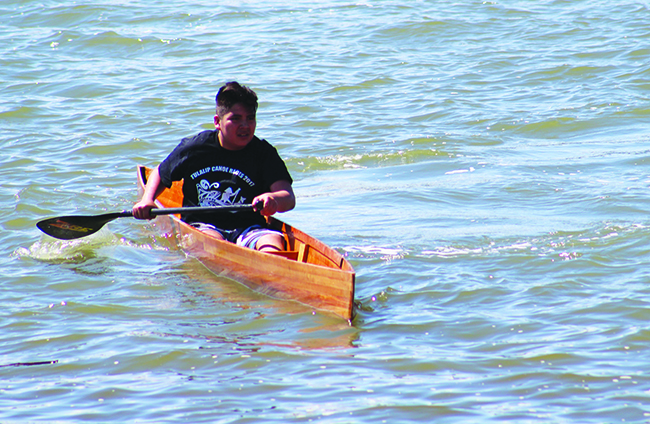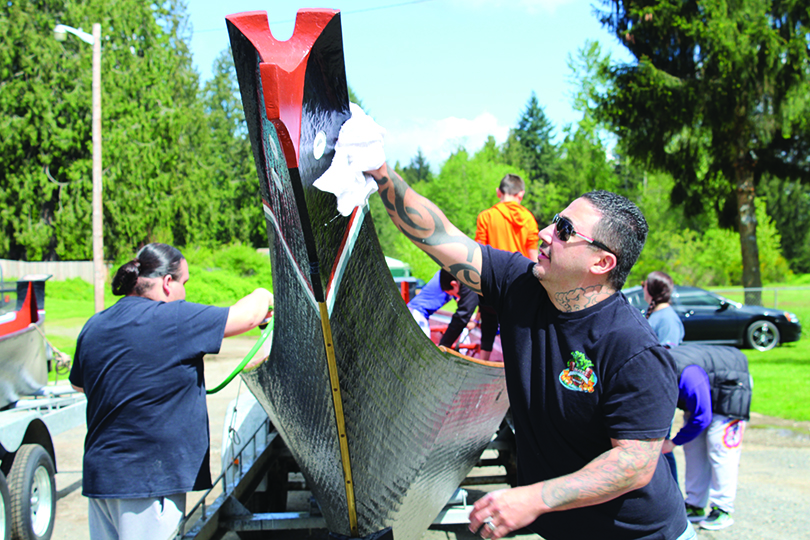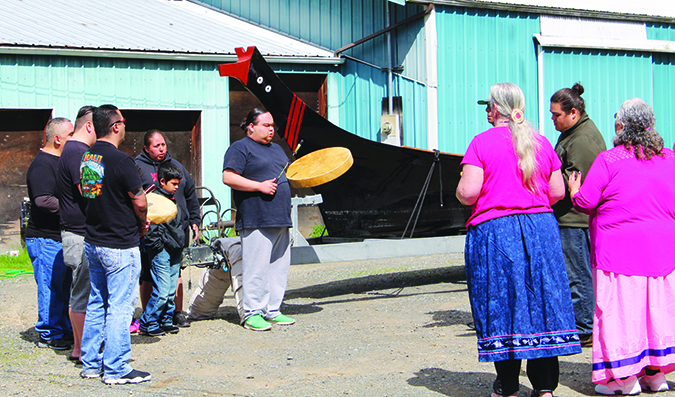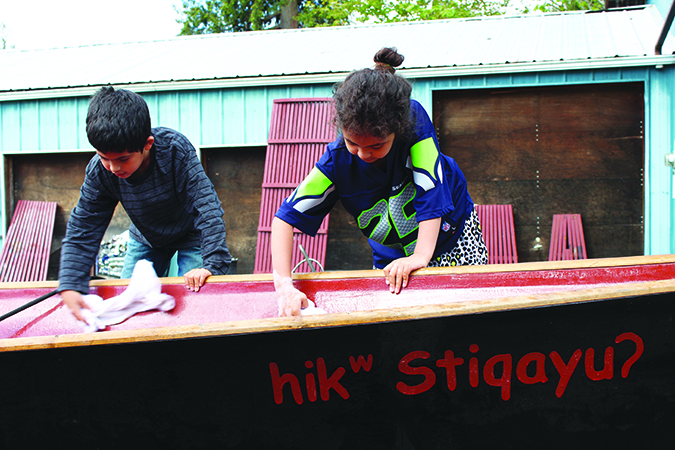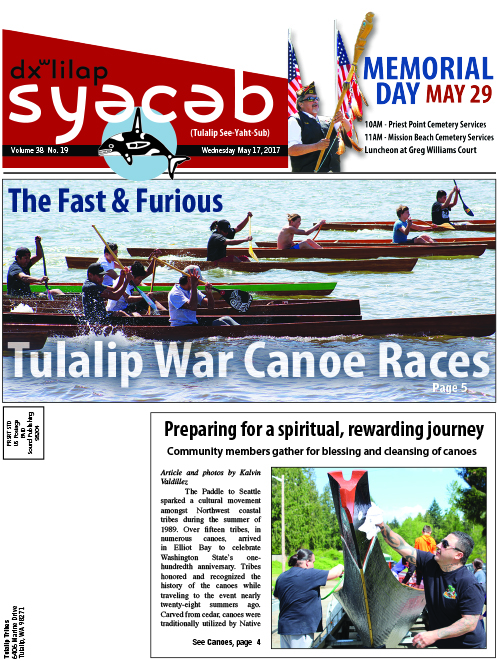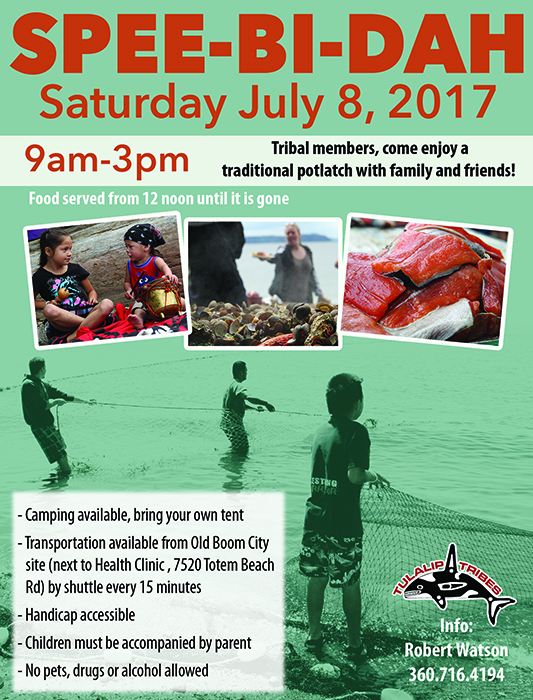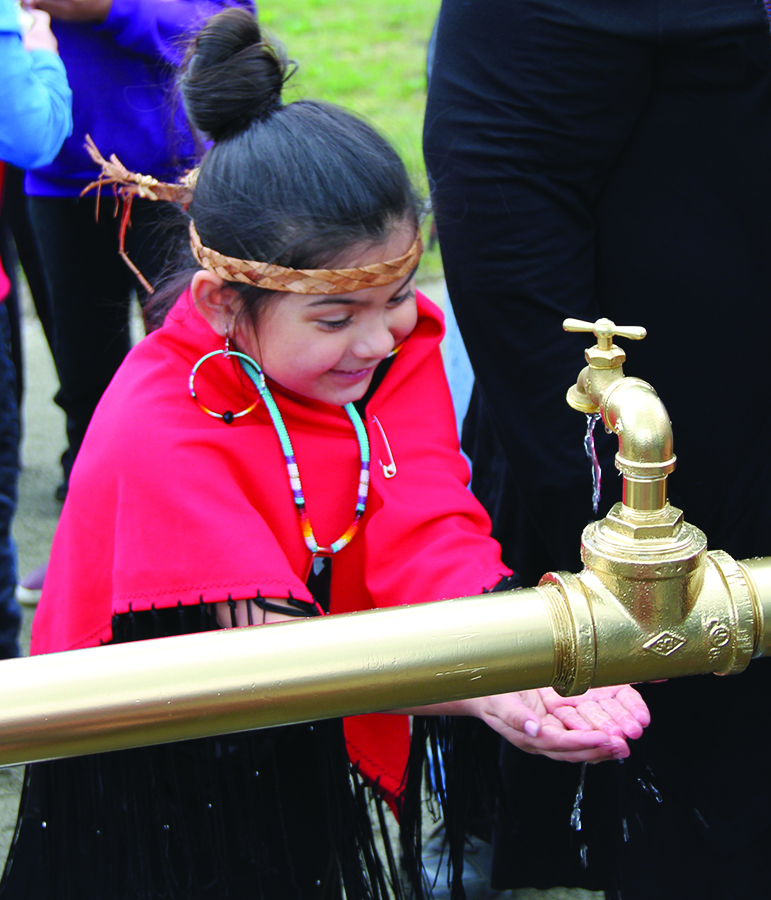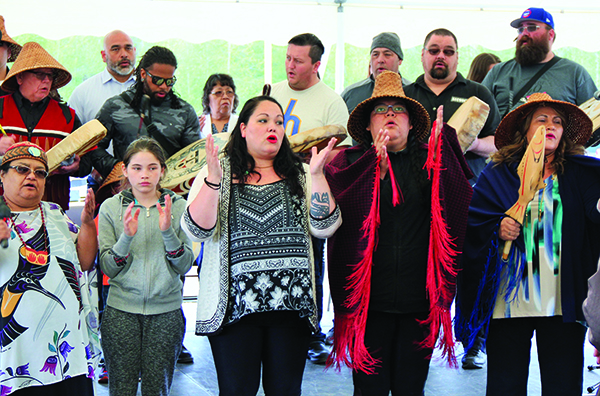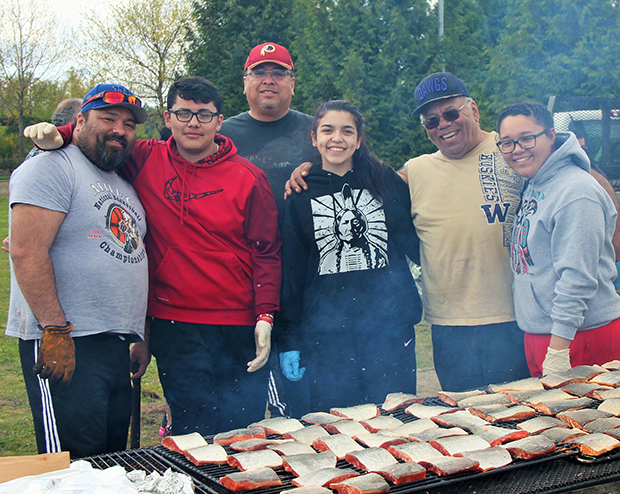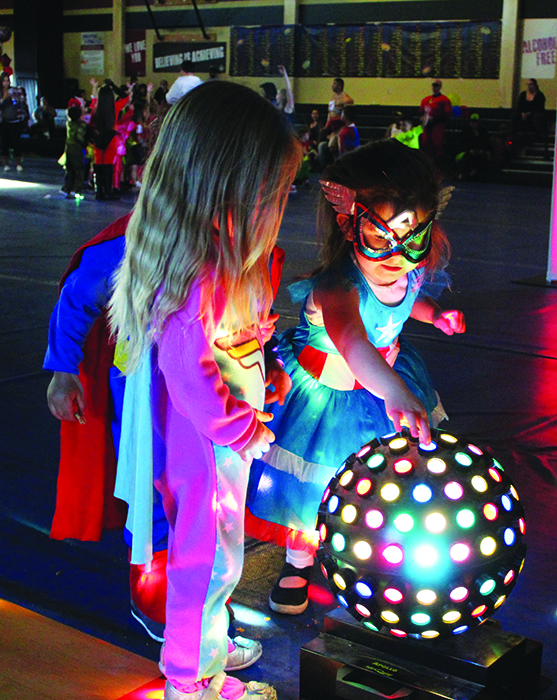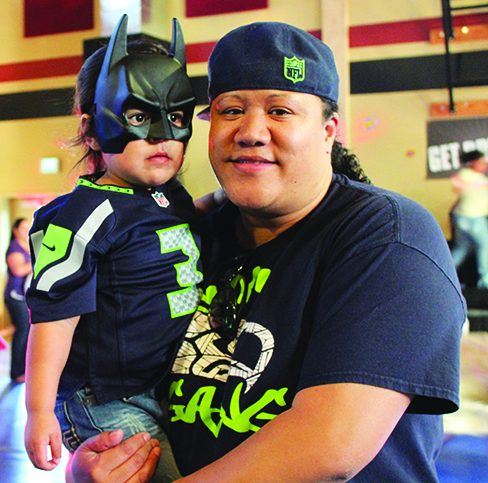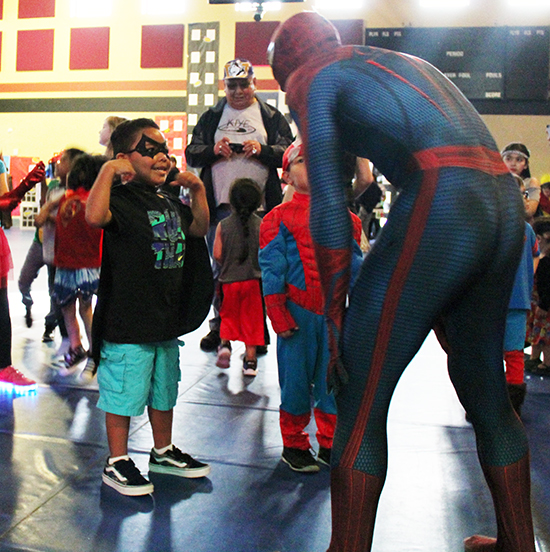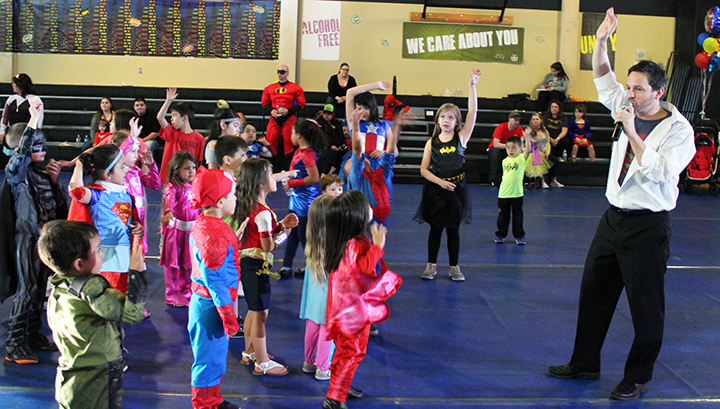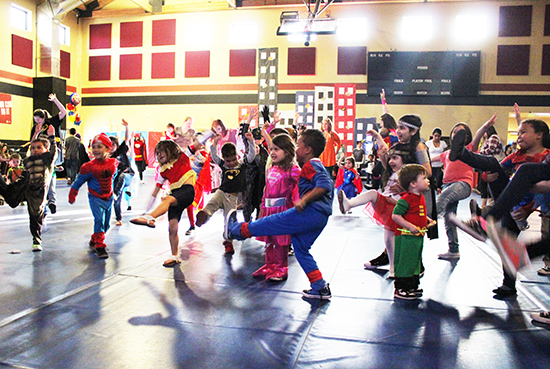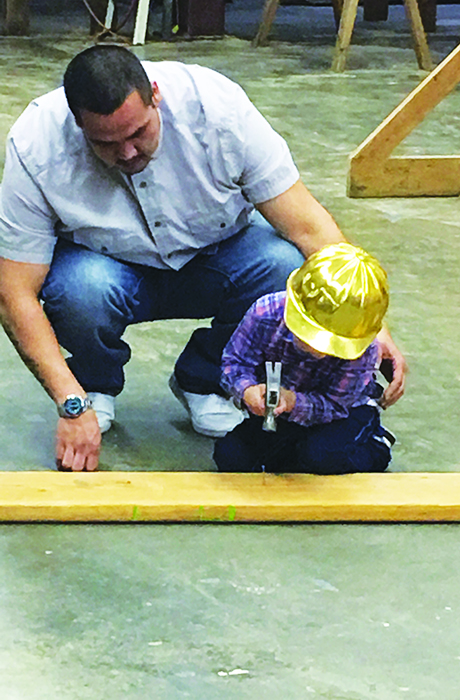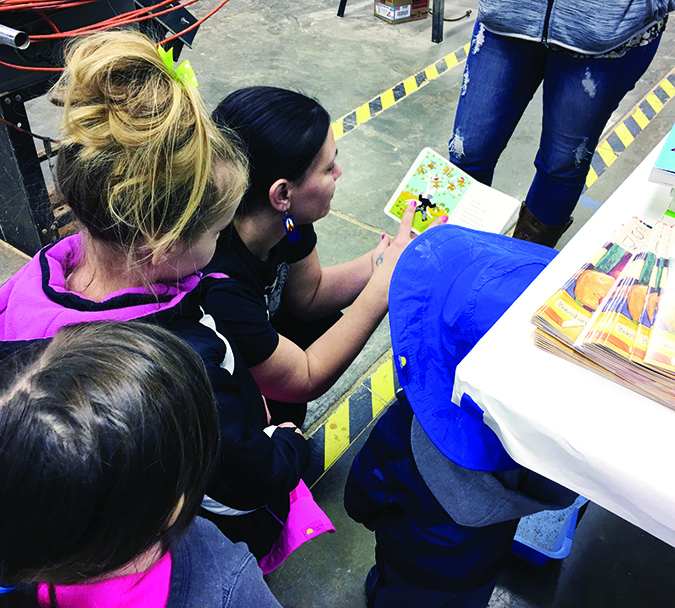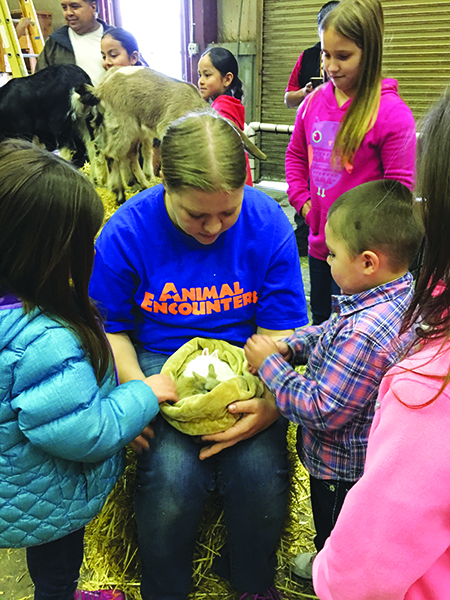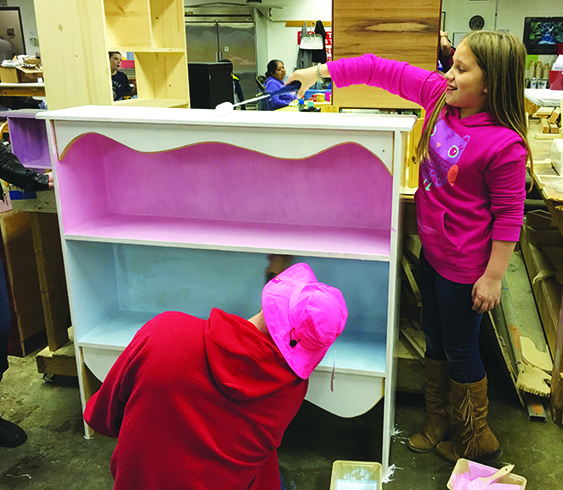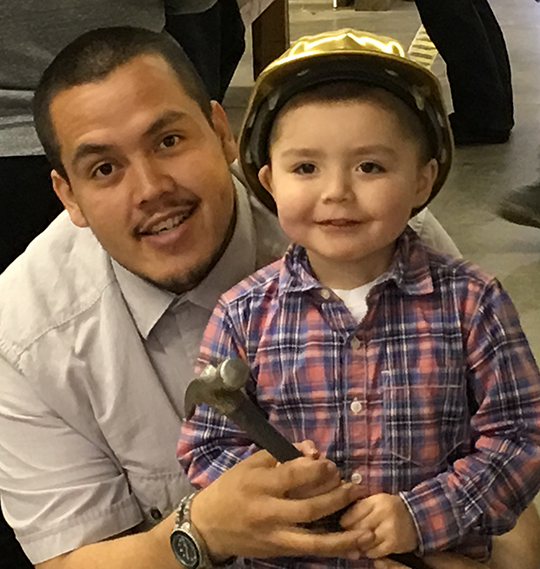Tulalip youth shine at ‘Living Breath’ Symposium
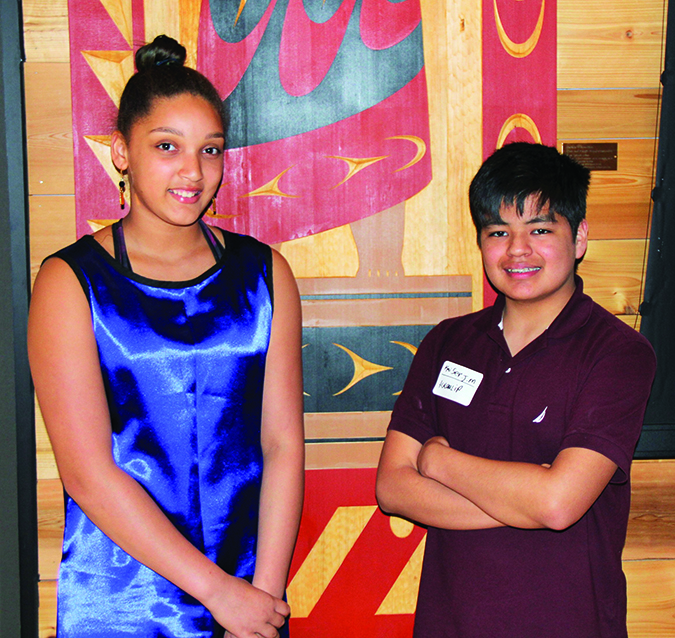
By Micheal Rios, Tulalip News
Over the weekend of May 5, the University of Washington’s longhouse, dubbed Intellectual House, held its 5th annual ‘Living Breath’ Symposium. This year was highlighted by Native youth grades 7th-12th who were willing to give a presentation or conduct an interactive workshop that aligned with Indigenous knowledge and tribal sovereignly.
After sifting through many deserving applicants, the Intellectual House advisory committee accepted a one-of-a-kind presentation from Tulalip youth who offered to share their experiences and knowledge gained as participants in Tulalip’s Mountain Camp program. Tribal members Jacynta Myles-Gilford, 7th grader, and Kaiser Moses, 8th grader, bravely conducted a 40-minute presentation, with little assistance, in front of a jam-packed Intellectual House audience on Friday, May 5.
Jacynta and Kaiser’s presentation was titled ‘Swedaxali: Huckleberry Fields Forever’. The young, prideful tribal members worked as a team and took turns on the mic describing their many experiences from their two summers participating in Mountain Camp. They shared critical details like how the camp is located in our ancestral mountain areas, which are now part of the Mt. Baker-Snoqualmie National Forest. Tulalip Tribes has reserved treaty rights to continue to hunt, fish and gather on these ancestral lands in the mountains, like Swedaxali (Lushootseed for “place of mountain huckleberries”). With a base camp at about 5,000 feet elevation, the area is very remote and beautifully untouched by the deconstruction that comes with urban areas.
They spoke of the many different kinds of plants that our ancestors used for medicinal purposes and as nourishment for their ever mobile bodies. Jacynta reminisced about walking in her ancestors’ footsteps while learning to make a traditional berry picking basket out of cedar bark from our grandmother cedar tree.
“My first summer at Mountain Camp was the first time I ever ate huckleberries. That was two years ago during a drought in that area, so they weren’t as ripe. The shrubs were dry and it was sad to see this usually lush green area look like that,” described Kaiser. “We still did all as planned and was still fun and enjoyable to pick the berries, eat them, make baskets and so on. At last year’s Mountain Camp adventure, there were so many berries, all of them were ripe and the taste was spectacular!”
As part of Mountain Camp last year, campers launched the very first work that is part of our Tribes’ 10-year plan to make sure huckleberries continue to grow in this area. The work they began in the huckleberry fields involved work to enhance the huckleberries’ growth by cutting down competing species that were shading out the berries and could prevent the mountain huckleberries from flourishing. This was a team effort by all the kids, camp staff and a few more volunteers. A highlight of their presentation, pictures and video were shown detailing the huckleberry stewardship work.
Concluding their presentation there was a question and answer segment provided for the many inquisitive minds in attendance. The huckleberry stewardship being diligently done by the Tulalip youth was further asked about. Jacynta provided an awesome response to one such question, “Working with the huckleberries and being taught how to take care of them like our ancestors once did is such an amazing experience. I feel we continue to gather berries in the area and take care of the plants in a good way like our elders teach. It’s really important to share our experience with others because then that means we are helping to spread the message behind Mountain Camp and what us youth are trying to do for the better of the Tulalip Tribes community.”
Dr. Charlotte Coté (Nuu-chah-nulth First Nation), chair of the UW’s Intellectual House Advisory Committee and co-founder of the ‘Living Breath’ Symposium, was among the audience who listened intently to Jacynta and Kaiser’s presentation.
“It was really inspiring to see young people from these Native nations understanding their culture, their traditions, and understanding it’s more than just about health. It’s about culture, community, family, and spirituality,” remarked Dr. Coté about the Tulalip youths’ presentation. “It’s all tied into connecting or reconnecting to your traditional foods and we really saw that in their presentation. You could tell they were speaking from their heart. It’s so important because this event focuses on youth so that we can inspire each other, but to also emphasize listening to the next generation. They are our future leaders, and here they are at such a young age understanding the importance of living their culture, while sharing their beautiful experiences with us.”
The Fast and Furious War Canoes
By Kalvin Valdillez
The Tulalip Tribes hosted the Annual War Canoe Races during the weekend of May 6, 2017. The two-day event attracts several Native communities including many Coast Salish tribal members as well as numerous First Nation band members from Canada. Racers, some as young as seven years-old, paddle rapidly through the waters of Tulalip Bay, in friendly competition, for a shot at the greatly desired first place title. Throughout the weekend races were held for singles and doubles as well as six and eleven-man teams.
Traditionally, canoes were made as a form of transportation for Northwest Natives as they navigated the waters to other tribes for various ceremonies. Canoes were also used during fishing and whaling trips as well as for raids. Due to the need for speed, traditional canoes were modified into faster models as tribes engaged in wars amongst each other by raiding villages.
Today, tribal nations gather in Tulalip once a year to cheer on their loved ones as they take to the waters, with their fellow racers, in war canoes. The races were on an extended hiatus and were recently revived during the summer of 2015. Tulalip tribal member and War Canoe Races Coordinator Natasha Fryberg spoke on the history, revival and importance of the races.
“Canoe races have been happening for many years. As far as Tulalip’s canoe race, we are not sure exactly when the last year Tulalip hosted the races [prior to the hiatus]. I was speaking with Art Humphreys during the canoe races and he was sharing with me that he remembers being here in the early 80’s, racing. Bringing the races back into our community was something that our uncle Herman Williams Sr. really pushed for. He pushed for our community to bring these canoes back to our people, ensuring that part of our history and identity is not forgotten. Thankfully canoe races are something that I feel very passionate about. I’m blessed by having the chance to coordinate the races and work with all the surrounding communities and travelers that come into our community and waters.
For many of us, we look at being in these canoes and learning about this way of life as a spiritual healing and blessing. We teach our youth at a young age that our canoes are live spirits and how to love and care for our canoes. That those trees that our canoes came from, gave themselves up for us to be able to go out on the water. Most importantly we use canoe racing as a way to promote a healthy lifestyle. To be able to give the children a place to go each day, to steer them away from what bad they may or may not get into,” stated Natasha. “Overall it is a humbling experience and I absolutely love it. I am only young and still learning myself, but I am more than willing to share what I have learned thus far.”
For those interested in racing and for additional information about the Annual War Canoe Races, please contact Natasha Fryberg at (425) 422-9276.
Cultural imPRINT: Northwest Coast Prints exhibition showcased at Tacoma Art Museum
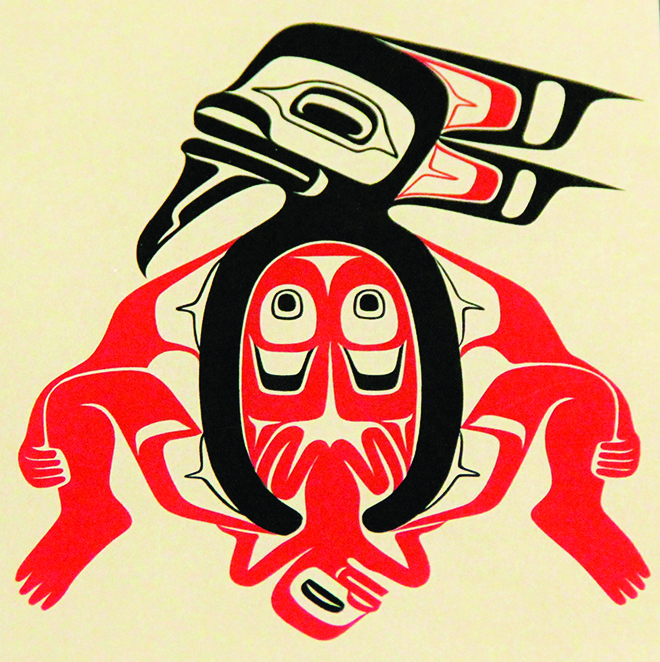
Haida First Nation
Untitled (Sara’s Birth Announcement), 1973
Screenprint
By Micheal Rios, Tulalip News
For generations, Coast Salish and First Nations artists developed visual language made up of colors, lines, shapes and space. These centuries-old designs can be recognized on cultural objects including basketry, carving, blankets and jewelry. When Coast Salish artists began printmaking in the 1960s, they translated their graphic languages onto a flat surface. The reproducible print medium raised visibility for Indigenous arts in the Pacific Northwest and beyond.

Coast Salish, Musqueam First Nation
Memory, 2005 Screenprint
*This mother-daughter collaboration won the City of Vancouver’s “Art Underfoot” competition in 2004. The design can be found on storm sewer covers throughout the Vancouver area.
The Tacoma Art Museum (TAM) is currently showcasing the vast styles of printmaking by tribal artists in its Cultural imPrint: Northwest Coast Prints exhibit. Reminding us of the local talent and cultural beauty inherent in works by artists from various First Nations and Native tribes along the Pacific Coast, you can take advantage of this special exhibition by visiting TAM now through August 20.
Faith Brower, TAM’s Curator of Western American Art, has partnered with co-curator India Young from Victoria, B.C. to bring together a selection of approximately 46 prints by 30 Coast Salish and Fist Nations artists.
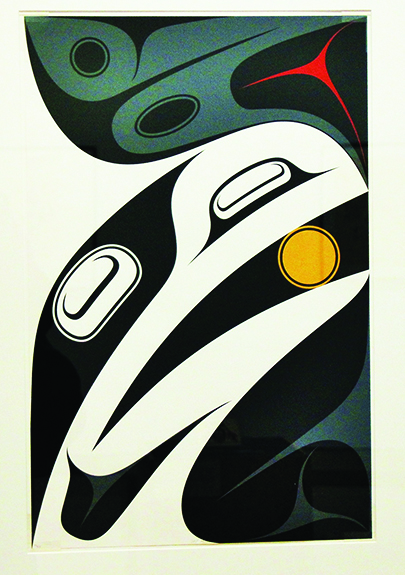
Haida First Nation
Just About, 2014 Screenprint
“This exhibition is really about how artists create community through their work,” said co-curator India Young. “Artists visualize their nationhood and territory. Cultural knowledge and design are passed from print to print and generation to generation. Prints circulate a sense of belonging.”
Providing a survey of Indigenous artists who have defined six-decades of printmaking in the Pacific Northwest, this exhibition proudly boasts a cultural narrative. Through their prints, these artists share knowledge about the diverse cultures in the region, while sustaining their art and history. Some of this artwork focuses on culturally specific design motifs that can identify a nation or tribe within the region. Others affirm how artists have used the print medium to reexamine the role of women’s histories with Northwest Coast communities. Still other works illuminate the passion of knowledge between generations.
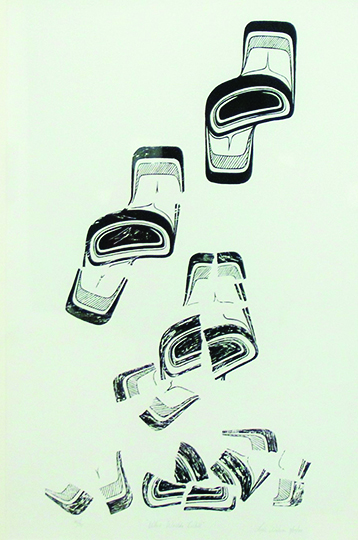
Haisla First Nation
When Worlds Collide, 1979
Screenprint
“What’s fascinating about this exhibition is the various interpretations of cultural symbols,” states co-curator Faith Brower. “These print works connect people in new ways to vibrant Northwest communities.”
Much of the printmaking from the Northwest Coast can be immediately recognized by the high contrast, black and red graphics. Indigenous printmaking in the region continues to be exploratory and innovative while adhering to traditional teachings. Through the print medium artists expand on their visual languages to create works that broaden the scope of Northwest Coast art.
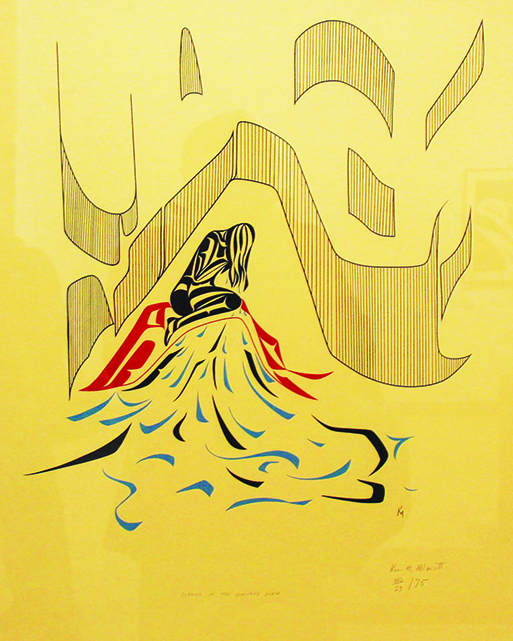
Gitxsan First Nation
Legend of the Avenged Flea, 1975
Screenprint

Gitxsan First Nation
Lynx’ Ooy’, 1980
Screenprint
Preparing for a Spiritual, Rewarding Journey
Community members gather for blessing and cleansing of canoes
By Kalvin Valdillez, Tulalip News
The Paddle to Seattle sparked a cultural movement amongst Northwest coastal tribes during the summer of 1989. Over fifteen tribes, in numerous canoes, arrived in Elliot Bay to celebrate Washington State’s one-hundredth anniversary. Tribes honored and recognized the history of the canoes while traveling to the event nearly twenty-eight summers ago. Carved from cedar, canoes were traditionally utilized by Native ancestors while hunting, fishing and traveling to other tribal villages during both times of celebration as well as war.
The event inspired the tribal nations to begin the Tribal Canoe Journeys in 1993 with the Paddle to Bella Bella, BC. Tribal Journeys is a summertime event in which multiple tribes travel together, from tribe to tribe, to a final landing destination. The tribes take turns hosting the final landing destination each year. After all canoes arrive at the final destination, a weeklong celebration ensues in which canoe families engage in traditional song, dance and storytelling.
The Canoe Journey, a drug and alcohol free event, allows many to reconnect with their culture. The Tulalip Tribes officially joined in on the festivities in 1997 during the Paddle to La Push, according to Skipper Harvey Eastman.
In preparation for this year’s Journeys, Paddle to Campbell River, Tulalip’s Rediscovery Program held a canoe cleansing event. Many Tulalip community members gathered at the Tulalip Veteran’s Park, on the morning of Sunday May 7, to witness the blessing and cleansing of the three family canoes. It is anticipated that one of them will be used to navigating the sacred waters during this upcoming summer.
“This is the way we want to begin our activities with the canoes, to include a spiritual cleansing because they have been in storage since the end of last years’ canoe journey. We know canoe travel was the mode of travel for our ancestors, and they lived a very spiritual life. There’s spirits in the water. This is also a spiritual journey as well as an opportunity to meet with our friends and relatives. We want it to be a good and spiritual awakening and rewarding journey to individuals as they learn many things about our culture along the way,” states Rediscovery Program Coordinator, Inez Bill.
Marcia Horne stated that the traditional blessing placed a protection shield on the canoes and the canoe families, while opening a clear path to Campbell River. Traditional Storyteller and Master Carver, Kelly Moses, spoke of the opportunity the event offers to tribal children in the wake of the nationwide heroin and opioids epidemic that is becoming more prevalent in many Native communities.
Following the blessing, community members were equipped with buckets of soapy water along with towels as they cleaned and prepped the canoes for the open waters.
“It’s new, but this is something that we wanted to have done, to prepare us for getting the canoes ready to be put on the water,” explained Inez. “I think it’s important we do that, just to clear our path and the path of the canoes, spiritually. We’re taking care of the canoe by washing it before it goes out on the water because it has been sitting for a year. It’s important that we take care of what we have and continue to honor and respect it because it is part of our teachings,”
Canoe pulling practice will begin in the near future as the Rediscovery Program continues preparation for this summer’s Tribal Canoe Journeys. The program is also holding a variety of gift-making classes at the Hibulb Cultural Center, open to all community members. Items made during these classes will be gifted during protocols at this year’s Journeys.
For additional information regarding the 2017 Tribal Canoe Journeys, please contact the Rediscovery Program at (360) 716-2635.
May 17, 2017 syəcəb
Please use the following link to download the May 17, 2017 issue of the syəcəb: https://www.dropbox.com/s/4in711zfnjkudp1/May%2010%2C%202017%20sy%C9%99c%C9%99b.pdf?dl=0
Spee-Bi-Dah, July 8, 2017
Celebrating 100 Years of Water for Our People, Salmon and Future
By Micheal Rios, Tulalip News
The usually vacant lot across from Boom City was anything but as hundreds of community members, tribal employees, and partners in interest gathered to celebrate the completion of the Tulalip Water Pipeline Project, affectionately called ‘Big Water’, on Friday, April 28.
The historical moment was treated as such with a traditional welcoming ceremony provided by the Tulalip Salmon Ceremony singers and drummers led by Glen Gobin. There was an open invite for all tribal members to join in with their drums and singing voices to perform a song passed down by Harriet Sheldon Dover, as well as a personal song belonging to Glen. Following the songs, Natosha Gobin gave a traditional prayer in both Lushootseed and English to bless the special occasion.
“Our ancestors knew that our survival as a people depended on the natural resources of our land and waters,” explained Tulalip Chairwoman Marie Zackuse. “In negotiating the Point Elliot Treaty, they ensured access to salmon were among the rights we reserved. We call ourselves the People of the Salmon. By preserving this precious resource we are defending our lifeways, our culture, and our identity.
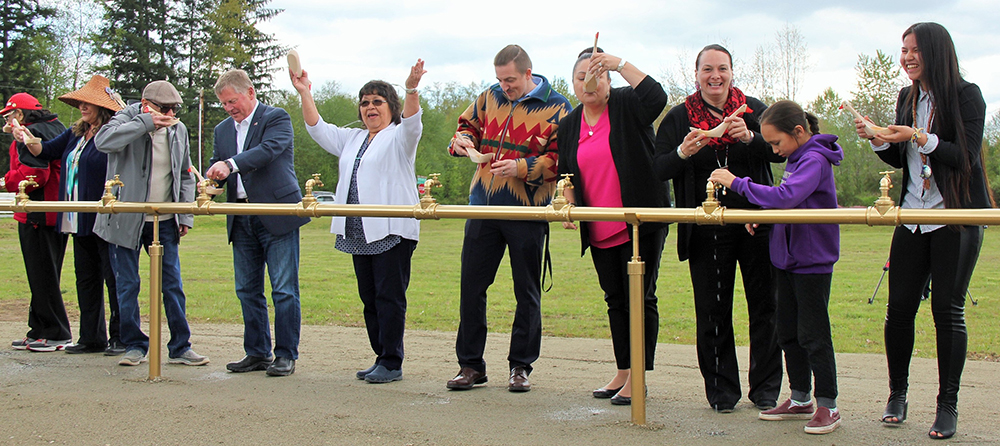
“The completion of this water pipeline is an historic event. We have secured water for our people and our future generations for the next hundred years. It took years of planning and years more to build the pipeline, which now carries water from Spada Lake to Tulalip. It will enhance our salmon recovery efforts, habitat restoration, and will provide a source of fresh water for our people now and into the future.”
Big Water has been heralded as the righting of a wrong committed against the Tribes long ago by the City of Everett, specifically when Everett built a diversion dam and tunnel to move water from the Sultan River to Lake Chaplain in 1916. The way the diversion was managed, there were times of the year that the Upper Sultan River was completely dry. Although the Lower Sultan River received enough water from other tributaries to allow salmon to spawn, miles of Upper Sultan River were no longer accessible to spawning fish resulting in massive population losses.
After years of court battles and lawsuits regarding the diversion dam and loss of waterways and salmon spawning habitat, the Tulalip Tribes and City of Everett began mending the long history of opposition and obstruction in 2003. The two governments have since moved towards a new era of consultation and compromise.
“What this was about more than anything was trust [between the City of Everett and Tulalip Tribes],” said Everett Mayor Ray Stephanson while recalling his father teaching him about the many injustices that happened to Native American people. “I never thought in my lifetime that I would have the opportunity to right a wrong, and this agreement really helped right a wrong.”
In 2016, the Snohomish County PUD created a fish passage around the old City of Everett diversion dam that made possible for 5-miles of spawning habitat to once again be available to salmon. Already fisheries staff have seen Coho and Steelhead in the area and are anticipating Chinook will return in the upcoming season. On Reservation, the Tulalip pipeline will supply approximately thirty-million gallons of water per day for the next one-hundred years.
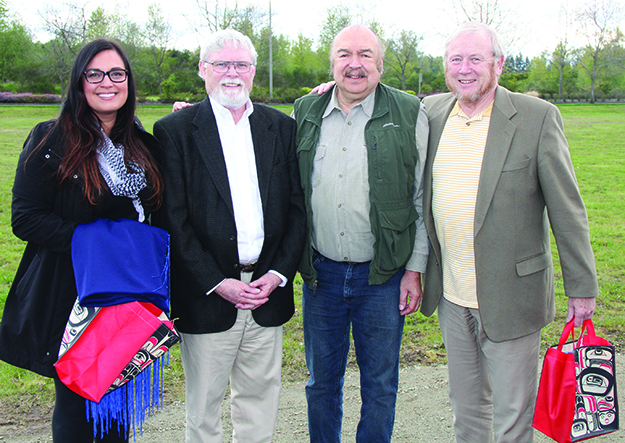
“Today’s celebration meant a completion of an agreement between the City of Everett and the Tulalip Tribes. It means potable water will be flowing to our homes to serve the needs of our families for the next 100 years and our streams will be augmented for our salmon and natural habitat,” stated Deborah Parker, Tulalip Tribal member and former Joint Water Pipeline Lead. “Our partnership reflects when two governments come together to work towards a solution. Many hours were spent meeting, negotiating, lobbying, and formalizing plans until final construction. The Joint Water Pipeline staff and leadership deserve a great deal of appreciation. It was truly an honor to be a part of this process and to witness the flow of water through the water line. Water is indeed an important part of our everyday life.”
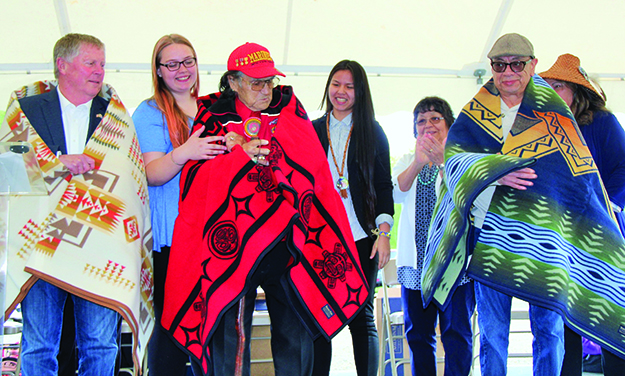
Highlighting the Big Water celebration was the ceremonial opening of the taps. The Board of Directors were joined by former Chairmen Stan Jones and Herman Williams, Jr. and Everett Mayor Ray Stephanson as they each turned a golden spigot to free a new source of life-giving water. Tribal Design provided hand carved ladles in the shape of a canoe for leadership to drink out of.
Concluding the celebration was a salmon bake feast cooked by Cy Fryberg and his family. Many attendees could be seen filling their gifted water bottles with water from the honorary golden pipes.
While Big Water is the culmination of many mission statements and priorities of the Tulalip Tribes, there are also plenty of ties to the ‘water is life’ slogan that has become omnipresent in Native communities across the country. Those sentiments were not lost on the diverse group of attendees, and in fact, it was a member of Tulalip’s younger generation who really summed it up best.
“Water is humanity’s basic need. Water affects everything from education to health to our future generations. They are the ones who will continue our legacy and our culture. The installment of the water pipeline will be innovating in our future by taking pressure off the water table. This will assist in the care of our ever-growing tribal community,” proclaimed Keely Gobin, vice-chairwoman of Tulalip’s Youth Council. “Prior to European settlers in the 1800s, the salmon returned to our area annually in huge numbers. Salmon and green life were the number one food source for our community. Settlement and the increasing population in the United States led to the development of dams and factories, which destroyed our local ecosystems, including our natural salmon runs and habitat. As sovereign people we must stand strong in the preservation of our Mother Earth, for she along with my great-great-grandchildren our counting on us to keep our waters pure. t’igwicid.”
Gee Willikers! Early Learning Students Answer Bat Signal
By Kalvin Valdillez, Tulalip News
The weather on the afternoon of Friday April 28 was perfect for travel conditions as the sun was shining and there was a slight breeze. Which was great news for the students of the Betty J. Taylor Early Learning Academy who, based on their capes and costumes, would presumably be flying, swinging from self-produced spider webs or driving customized all-black armored vehicles to the Greg Williams Court to bust a move for the first Annual Spring Dance hosted by the Parent Committee of the Academy.
Each year the spring dance will offer a new theme, where the children get to dress up in costumes while getting their groove on. The first year did not disappoint as the kids were incognito in costumes such as Captain America, Wonder Woman, Batman, Batgirl and Spiderman for the superhero theme, which was fitting as the dance fell on National Superhero Day.
Upon entry to the gym, the kids were instantly transported into another world – of comic books! Decorations made by teachers and parents were remarkable as the inside of the gym mirrored the city of Metropolis, home to Superman. A live DJ engaged the kids during group dances and activities. Many parents got into the spirit as well, dressing as their favorite superheroes and joining their children in several dances including the Cha-Cha Slide and a conga line that turned into the limbo dance.
Gasps, screams and shrills of excitement were heard from students upon the arrival of special guests Batman and Spiderman, who danced with the students for the entire evening. Families showed up by the masses, with over three hundred people, according to the Early Learning Academy’s Family/Community Coordinator, Katrina Lane.
The first ever Annual Spring Dance was a success as evidenced by the large turnout and the many smiles from the students as they zoomed across the gym showing off their incredible speed and their special crime fighting moves.
Money is raised for the dance by the parents of the Academy and through various fundraisers, such as auctions and book fairs.
Petting Zoo and Story Time Enhance Family Day
By Micheal Rios, Tulalip News; photos by Lynne Bansemer
The latest cohort of TERO Vocational Training Center (TVTC) students made some pretty cool memories with their family and friends during the spring session’s ‘Family Day’.
“We set aside a day every session to bring families together, allowing for the children of students to visit the training center and experience their parents’ success,” says Lynne Bansemer, Tulalip TERO Coordinator. “Family Day focuses on literacy as well. We partnered with Sno Isle Libraries who come in for storytelling, library card sign-up, book check out, and this year they brought gifts of learning materials and books. With funds provided by a grant, WKKF (Kellogg Foundation), TVTC made a large book purchase allowing for each child to leave with five brand new books.”
Making the day even brighter for everyone was the transforming of the training center into a temporary petting zoo filled with farm animals and even a young kangaroo. Animal Encounters provided the group of furry and feathered friends for both the kids and adults to hold and pet.
The gathering of students with their young children also allowed for some hands-on experience with trade skills. Several of the kids assisted their parents putting final touches on their personal projects. Whether it was hammering a nail or adding additional flare with some bright colored paint, the children apprentices made their presence felt.
“It really meant a lot to me for my son to watch me working at the training center and witness the positive things I’m doing with my life,” says TVTC student and Tulalip tribal member Rocky Harrison about his son Rocky Jr. participating in Family Day. “It helps instill good morals and work ethic into him at a young age seeing his father learning and doing hands on work. It brings me great pleasure to know that I am being the best father I can be to my son and that I am able to show him what it means to be a good father and hardworking man.”
